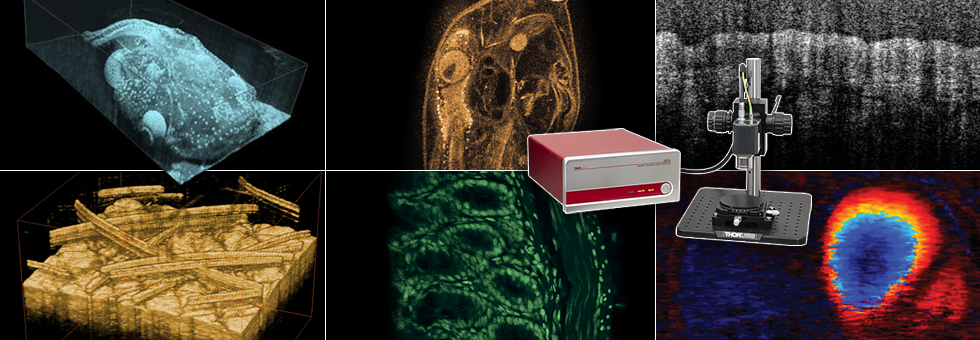OCT Identifies Malignancies


Please Wait
Lymph Node Malignancies Identified with OCT
Featured Researchers:
R. A. McLaughlin, L. Scolato, P. Robbins, S. Hamza, C. Saunders, and D. D. Sampson
|
The current gold standard for identifying malignant lymph nodes, histological assessment, can only be performed ex vivo and thus requires surgical excision. As a result of dissecting all or most regional axillary nodes, healthy lymph nodes are also removed. This can lead to complications, most notably lymphedema, which is a chronic condition characterized by fluid retention and tissue swelling.
Figure 1.1 Comparison of H&E histology (a) and an OCT image (b) of a human lymph node. The cortex (labeled C), paracortex (labeled PC), and medulla (labeled M) are evident in both frames, as is an area of tumor-permeated tissue (labeled T). Recently, Optical Coherence Tomography (OCT) has received attention as a promising optical imaging modality for in vivo assessment of cancerous breast tissue. Images are acquired with this noninvasive imaging technique by detecting backscattered light from various depths within tissue. OCT requires neither excision nor staining, making it a particularly attractive option for preserving nonmalignant lymph nodes and avoiding lymphedema in breast cancer patients. In this article, we summarize recent research efforts by McLaughlin et al.1, which demonstrate that OCT is capable of differentiating cancerous from noncancerous tissue, as well as the constituent compartments associated with a lymph node. During the experiment, 2 mm thick slices of lymph node samples were excised from breast cancer patients, mounted on glass plates, and immersed in glycerol to reduce the refractive index mismatch between the glass slides and samples. OCT images were obtained using a Thorlabs Swept-Source OCT system (central wavelength: 1325 nm, spectral bandwidth: 100 nm) that provided an imaging depth of approximately 3 mm over the 10 mm x 10 mm field of view. In Figure 1.1, an OCT image (b) of a sample lymph node is compared to H & E histology (a), the current gold standard for detecting malignancies in tissue. As shown in Figure 1.1 (a), the three compartments of the lymph node - the cortex, paracortex, and medulla - as well as an area of malignant tissue are visible in the resulting OCT image from a patient with ductal breast carcinoma. The high amount of backscatter associated with the tumor-permeated tissue, indicated by a T in Figure 1.1, leads to a dark region amidst the lighter, healthy cortical tissue. It is believed that the increased backscattering associated with the presence of metastatic deposits is caused by a change in both the size and texture of the cell nuclei.2 OCT's ability to noninvasively image microscopic features within tissue make this NIR imaging modality a strong candidate for future detection of cancerous lymph nodes in breast cancer patients. In addition, this technique shows promise for monitoring changes in lymph node structure resulting from therapy. |
References:
1) R. A. McLaughlin, L. Scolaro, P. Robbins, S. Hamza, C. Saunders, and D. D. Sampson. Imaging of Human Lymph Nodes Using Optical Coherence Tomography: Potential for Staging Cancer. Cancer Res. 70, 2579 - 84 (2010).
2) A. Wax, C. Yang, M. G. Muller, et al. In situ detection of neoplastic transformation and chemopreventive effects in rat esophagus epithelium using angle-resolved low-coherence interferometry. Cancer Res. 63, 3556-9 (2003).
The techniques used in these studies were approved by the Human Research Ethics Committee of Sir Charles Gairdner Hospital. Informed consent was obtained from participating patients.
| Posted Comments: | |
| No Comments Posted |
 Products Home
Products Home
 Lymph Node Malignancies
Lymph Node Malignancies